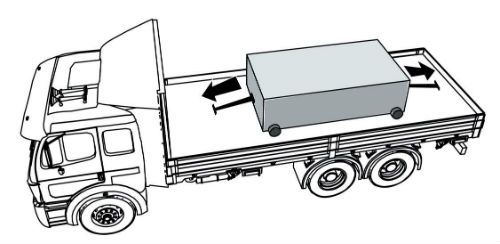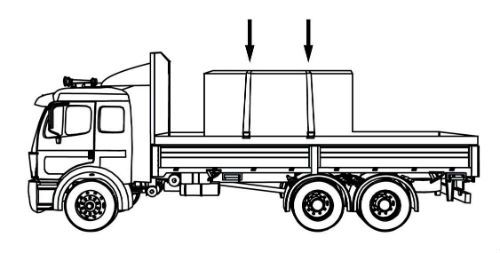CDL Practice Tests: Flatbed Cargo Securement
Choose A Section:
Go!What is a pallet used for?
- A vertical barrier across a vehicle to prevent forward movement of cargo.
- A waterproof sheet used to cover cargo.
- A vertical barrier across the front of the deck of a vehicle to prevent forward movement of cargo.
- A platform or tray on which cargo is placed so that it can be handled as an article. (Same as "Skid")
Pallet:
A platform or tray on which cargo is placed so that it can be handled as an article. (Same as "Skid")
A container chassis vehicle is defined as:
- A structure, device, or another substantial article placed against an article to prevent it from tipping that may also prevent it from shifting.
- A reusable, transportable enclosure that is especially designed with integral locking devices that secure it to a container chassis trailer to facilitate the efficient and bulk shipping and transfer of goods by, or between various modes of transport, such as highway, rail, sea, and air.
- A specialized container, primarily used to contain and transport materials in the waste, recycling, construction/demolition, and scrap industries, which are used in conjunction with specialized vehicles, in which the container isloaded and unloaded onto a tilt frame body by an articulating hook-arm.
- A vehicle especially built and fitted with locking devices for the transport of intermodal containers.
Container Chassis Vehicle:
A vehicle especially built and fitted with locking devices for the transport of intermodal containers.
When securing paper rolls with eyes crosswise, which of the following can be used to prevent side-to-side shifting when there is more than 8 inches of space to the wall?
- Any of these methods are acceptable.
- Tiedowns.
- Friction mats.
- Void fillers.
Requirements for eyes crosswise: prevent rolls from shifting toward either wall
If there is more than a total of 203 mm (8 in) of space between the ends of a paper roll and other rolls or the walls of the vehicle, use one of these methods:
- Void fillers (such as honeycomb)
- Blocking
- Bracing
- Friction mats
- Tiedowns
A device placed between the deck of a vehicle and car or between articles of cargo, intended to provide greater friction than exists naturally between these surfaces is:
- A friction mat.
- A chock.
- A cleat.
- Void filler.
Friction mat:
A device placed between the deck of a vehicle and car or between articles of cargo, intended to provide greater friction than exists naturally between these surfaces.
Define 'bolster':
- A structure, device, or another substantial article placed against or around an article to prevent horizontal movement of the article.
- A vertical barrier across the front of the deck of a vehicle to prevent forward movement of cargo.
- A crosswise load bearing structural component, particularly a part of a log bunk.
- An inflatable bag intended to fill otherwise empty space between articles of cargo, or between articles of cargo and the wall of the vehicle.
Bolster:
A crosswise load bearing structural component, particularly a part of a log bunk.
Specific securement methods are required for boulders that:
- Have more than five distinct sides.
- Weigh more than 5,000 lbs, or have a volume of more than 4 cubic meters.
- Weigh more than 11,000 lbs, or have a volume of more than 2 cubic meters.
- Weigh more than 5,000 lbs, or have a volume of more than 1.25 cubic meters.
The requirements in this section apply to any piece of natural, irregularly shaped rock that:

Weighs more than 5,000 kg (11,000 lb.) or has a volume greater than two cubic meters
Is transported on an open vehicle or in a vehicle whose sides are not designed and rated for the transportation of boulders.
Requirements for securing a non-cubic shaped boulder with a stable base include all of the following except:
- Pass the tiedowns over the center of the boulder
- Secure each boulder individually with at least two chain tiedowns forming an X pattern over the boulder.
- Attach chains together at the intersection
- Wrap chains around the circumference of the boulder.

Secure each boulder individually with at least two chain tiedowns forming an X pattern over the boulder.
Pass the tiedowns over the center of the boulder and attach them to each other at the intersection by a shackle or other connecting device.
What is a cab shield?
- A vertical barrier across the front of the deck of a vehicle to prevent forward movement of cargo.
- A structure, device, or another substantial article placed against or around an article to prevent horizontal movement of the article.
- A vertical barrier placed directly behind the cab of a tractor to protect the cab in the event cargo should shift forward.
- The depression formed between two cylindrical articles when they are laid with their eyes horizontal and parallel against each other.
What is a headboard?
- A vertical barrier across the front of the deck of a vehicle to prevent forward movement of cargo.
- A vertical barrier across a vehicle to prevent forward movement of cargo.
- A transverse load bearing structural component, particularly a part of a log bunk.
- A vertical barrier placed directly behind the cab of a tractor to protect the cab in the event cargo should shift forward.
Headboard:
A vertical barrier across the front of the deck of a vehicle to prevent forward movement of cargo.
Within the requirements for concrete pipe, which of these requires specific securement methods?
- Concrete pipe eyes vertical and concrete pipe loaded lengthwise.
- Concrete pipe that is grouped together into a single rigid article and may not roll.
- Concrete pipe loaded in a sided vehicle or container.
- Concrete pipe loaded cross-wise on a flatbed trailer.
What is exempt from these specific requirements?
Follow general cargo securement requirements (Section 2) when transporting the following pipe:
- Concrete pipe that is grouped together into a single rigid article and may not roll.
- Concrete pipe loaded in a sided vehicle or container.
- Concrete pipe eyes vertical and concrete pipe loaded lengthwise.
What is covered under these specific requirements?
Any concrete pipe loaded crosswise on a platform trailer or vehicle that is not exempt.
About The Flatbed Cargo Securement CDL Manual
Studying the flatbed cargo securement CDL manual is not a requirement for getting your CDL permit or license. It is required knowledge for flatbed drivers.
Some questions you should be able to answer for flatbed cargo securement:
- What is the minimum Working Load Limit of a tiedown used to secure logs?
- What is the minimum weight of a shipment of paper rolls that would require specific securement requirements?
- When securing concrete pipe over 45 inches loaded crosswise, which direction must the tiedowns on the front half of the load run?
- What is a cab shield?
- When securing concrete pipe over 45 inches loaded crosswise, which direction must the tiedowns on the rear half of the load run?
- What is a dunnage bag?
- Who is responsible for inspecting securing devices and cargo within the first 50 miles?
- How many tiedowns are required on a stack of shortwood loaded crosswise?
- What is the minimum working load limit of each tiedown used to secure crushed or flattened vehicles?
- Define 'bolster'
- What is a hook-lift container?
- When a tiedown is attached directly to the cargo, what is the ideal angle where it attached to the vehicle?
What is a securing device?
Any device specifically manufactured to attach or secure cargo to a vehicle or trailer:
- Synthetic Webbing
- Chain
- Wire rope
- Manila rope
- Synthetic rope
- Steel strapping
- Clamps and latches
- Blocking
- Front-end structure
- Grab hooks
- Binders
- Shackles
- Winches
- Stake pockets
- D-rings
- Webbing ratchet
- Bracing
- Friction mat
What is a tiedown?
A combination of securing devices that forms an assembly that:
- Attaches cargo to, or restrains cargo on a vehicle.
- Is attached to anchor point(s).

Some tiedowns are attached to the cargo and provide direct resistance to restrain the cargo from movement.

Some tie-downs pass over or through the cargo. They create a downward force that increases the effect of friction between the cargo and the deck. This friction restrains the cargo.
 Related Cargo Securement Terms That Every Driver Should Know:
Related Cargo Securement Terms That Every Driver Should Know:
-
Tiedown:
A combination of securing devices which form an assembly that attaches cargo to, or restrains cargo on, a vehicle or trailer, and is attached to anchor point(s).
-
Contained:
Cargo is contained if it fills a sided vehicle, and every article is in contact with or sufficiently close to a wall or other articles so that it cannot shift or tip if those other articles are also unable to shift or tip.
-
Blocking:
A structure, device, or another substantial article placed against or around an article to prevent horizontal movement of the article.
How should tiedowns be attached?
Tiedowns can be used in two ways:
-
Attached to the cargo:
- Tiedowns attached to the vehicle and attached to the cargo.
- Tiedowns attached to the vehicle, pass through or aroundan article of cargo, and then are attached to the vehicle again.
-
Pass over the cargo:
- Tiedowns attached to the vehicle, passed over the cargo, and then attached to the vehicle again.
Tiedown placement:

Place the tiedown as close as possible to the spacer.
Position the tiedowns as symetrically as possible over the length of the article.

Position the tiedowns to preserve the integrity of the article.







 TT On Facebook
TT On Facebook